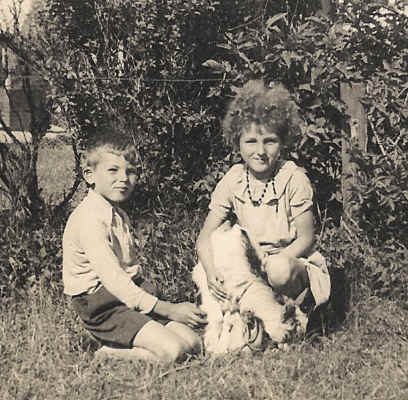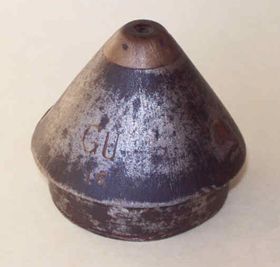
Recollections of Vliegveld Ockenburg and Kijkduin during War Time
door John van de Wouw
De schrijver van dit verslag woonde sinds 1947 in de Verenigde Staten en is daarom in het Engels gesteld.
As a seven-year-old living on the Duinlaan 123 in Kijkduin, I can still vividly remember the events leading up to the "Mei Dagen 1940" and the subsequent events that occurred around het vliegveld Ockenburg.
Several months and weeks prior to the beginning of hostilities, preparations for the defense of Ockenburg (and presumably Den Haag) were being made. Approximately four or five airplane hangars were constructed on the North side of the Kijkduinse Straat across from Ockenburg. It would appear that the concept was to utilize the Kijkduinse Straat as a runway for the Dutch Airforce planes. The hangars were only partially completed and never utilized as such. Shortly after the end of fighting, they were dismantled.

One other activity, the quartering of Dutch soldiers in the Kijkduinse School, pointed to the upcoming conflict. A small contingent, probably a Company or less, was stationed at the school and were of great interest to us school kids - soldiers in uniform are always an attraction. The troops were required to perform close order drill on the Kijkduinse Straat which was a two way street with a center median perfectly suited for drill. A very junior, probably second lieutenant, officer had the responsibility to call out the marching orders and to the irritation of his senior officer, did not have the military voice to properly command the troops.
In the early hours of 10 Mei 1940, before sun-up, we were awakened by noises in the front yard and patio. It turned out to be a small group, probably a squad, of Dutch soldiers making themselves at home on the patio. They proceeded to dig shallow trenches along the hedge facing the Duinlaan and the meadows between Meer and Bos and the Kijkduinse Straat/Ockenburg. Presumably this contingent had the duty to keep German troops from moving out of Ockenburg, over the Duinlaan towards Den Haag. They were very relaxed, enjoyed the tea and cookies my Mom was serving continuously, and in any case were poorly prepared for any major conflict having only their rifles for armament. After a couple of days, they left as suddenly as they had arrived.
The early period of the conflict was predominated by the large number of German Junkers flying low overhead and dropping parachutists over and to the South of Ockenburg. Many planes landed and when trying to take off again, found the wet ground too soft and got stuck. These and other planes were under continuous fire from Dutch troops stationed on the periphery of the airport, many of the planes catching fire or being disabled. After several days of this, the airport appeared to be covered with airplane wreckage and not able to absorb any more landings. Several Junkers utilized the beach area as a landing strip with more or less success, taking off again was not an option in any case.
 While watching all this excitement with my Dad, standing in the front yard, we heard a soft "plop" only a foot or two behind us and found that the front-end part of an artillery shell had landed there. We proudly showed our still warm souvenir around. Our neighbor was quite jealous, however only about 30 minutes later, he came over, holding a complete artillery shell, which without exploding, had crashed through his roof, landing in the living room. I still have my souvenir and after contacting the Nederlands Artillerie Museum in 1999, found out that it is from a brisantgranaat from a Dutch 75mm artillery piece, probably fired by the Dutch Artillery that while stationed in Poeldijk had Ockenburg under fire (see De Slag om de Residentie, by Maj. E.H.Bongers).
While watching all this excitement with my Dad, standing in the front yard, we heard a soft "plop" only a foot or two behind us and found that the front-end part of an artillery shell had landed there. We proudly showed our still warm souvenir around. Our neighbor was quite jealous, however only about 30 minutes later, he came over, holding a complete artillery shell, which without exploding, had crashed through his roof, landing in the living room. I still have my souvenir and after contacting the Nederlands Artillerie Museum in 1999, found out that it is from a brisantgranaat from a Dutch 75mm artillery piece, probably fired by the Dutch Artillery that while stationed in Poeldijk had Ockenburg under fire (see De Slag om de Residentie, by Maj. E.H.Bongers).
The fighting continued on and around Ockenburg, but from our location in Kijkduin we were isolated from being directly impacted, the vliegveld being approximately 1km to the South East. At some point, the small wooden buildings in the Folks Tuintjes to the South of Meer en Bos were set aflame, probably by the Dutch troops to preclude cover to the Germans, and burnt to the ground. The weather during all this time was picture perfect, full sun, not a cloud in sight, warm spring weather, and strangely enough, two German paratroopers (without any weapons that I recall) calmly strolled through our yard, apparently from the beach area heading towards Ockenburg, as if on a casual walk. On 14 May, we could see the large smoke cloud and the massive cumulus cloud to the SouthEast that was the result of the disastrous bombing of Rotterdam, leading to the capitulation on 15 May 1940.
After the capitulation, we explored some of the areas around Kijkduin. The Junkers on the beach were a key attraction. Smelling strongly of aviation fuel leaking from broken tubing it is a wonder they did not all go up in flames since there were quite a few people in/on/around the planes. It was a kid's delight especially since much equipment was scattered around. A motorcycle with sidecar (and flat tires) outside one of the planes was stuck in the sand and made for a good piece of play equipment. Being another beautiful spring day, many people on bicycles were also exploring. On the bike path leading into Kijkduin, they encountered a Dutch soldier (un-armed) stationed there to keep people from taking souvenirs off the battlefield. Parachute cord and silk were favorite items. The soldier implored people not to take things, but often got ignored. Out of desperation he asked them how they would feel if people would take items that had belonged to their friends and family members. It persuaded some to leave the souvenirs behind.
Vliegveld Ockenburg was turned into a "schijn vliegveld", perhaps to lure unsuspecting Allied planes into landing there. At first reed fencing was installed along the Kijkduinse straat to keep things out of sight. Blue and red landing lights were installed and turned on at night when Allied planes were returning to England after in-land sorties. The word among the kids was that an English plane actually did make an emergency landing there. Only recently was that story actually confirmed (see Website Vliegveld Ockenburg). Another story making the rounds was that there were wooden fake planes placed on the airport. Small caliber anti-aircraft guns must have been installed since occasionally low flying Allied planes would come under attack at night with tracer ammunition, quite a colorful display, but never saw any negative results as related to the planes.
German troops were quartered in the Kijkduinse School (kids were moved to the Dalton HBS) and in the hotel at the end of the Kijkduinsestraat. The tank canal and bunkers were constructed around Kijkduin as part of the Atlantic Wall and civilians were ordered to evacuate Kijkduin in November 1942.
After the war, in mid 1945, now 12 years old, we again explored the Kijkduin area. Everything was deserted. Many of the houses (including Duinlaan123) had been torn down completely, providing for a clear-field-of-fire and in some cases for bunker building materials. The bunkers were a delight to explore with all their heavy guns still in place. A concerned Dutch soldier chased me away from Ockenburg with the warning of unmarked mine fields. There was an item of interest to me however. At the entrance to the vliegveld was a small brick guard house/shack. All the woodwork had been broken out and burned. The white plaster walls were covered completely with what I think and remember as Hebrew writing made with what appeared to be charcoal. I have never been able to find out what that may have been associated with. (JvdW 2009: probable these writings where from the Jewish Brigade Group -part of the British Army- who supervised the mine clearing operation on Ockenburg).
w.g. John van de Wouw
Californie, februari 2005